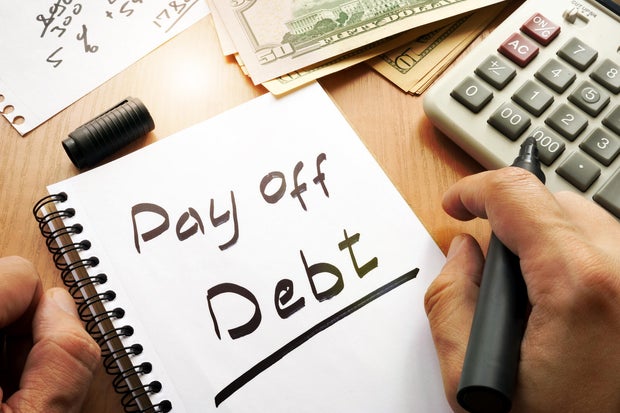 If you're trying to pay off debt, don't overlook the simple but clever strategies that will help expedite the process.
Getty Images/iStockphoto
If you're trying to pay off debt, don't overlook the simple but clever strategies that will help expedite the process.
Getty Images/iStockphoto
Struggling with debt is more common than many people realize, especially in today's economic landscape. The total amount of credit card debt nationwide recently surpassed $1.21 trillion, with credit card balances alone averaging around $8,000 per borrower. For millions of borrowers, though, these aren't just numbers. They're major sources of financial stress that impact daily decisions, from what groceries to buy to whether it's possible to save for retirement.
Your debt issues don't have to feel like an endless burden, though, whether you're dealing with a high-rate credit card balance or overwhelming personal loan debt. While you do need to handle your debt as soon as possible, there are creative, effective ways to reduce your balances, some of which can cut years off your repayment plan. The key is finding the approaches that fit your situation without adding undue pressure.
Find out how you can start the debt relief process now.
What are the clever strategies for paying off debt?
The most effective debt elimination approaches typically go far beyond simply paying more than the minimum. These approaches combine psychological tactics with mathematical precision. Here are some of the more clever strategies you can use to accelerate your debt repayment timeline:
Use the classic snowball and avalanche methods
How you prioritize your repayments can significantly affect your debt repayment timeline and interest costs, which is where the snowball and avalanche methods come in. The snowball method targets the smallest debts first to generate psychological momentum, while the avalanche method focuses on debts with the highest interest rates to minimize overall interest paid. Aligning your approach with both financial and motivational goals can improve consistency and results.
Learn more about the debt help available to you today.
Take advantage of low-rate borrowing offers
Credit card companies regularly offer low-rate or 0% interest balance transfer offers that can range from 12 to 21 months or more. If you qualify, moving your high-rate debt to a card with this type of promotional rate can provide breathing room and reduce the interest rate or erase it entirely during the promotional term, allowing you to pay less in interest and expedite the repayment process.
Note, though, that this approach requires discipline. Missing a payment or letting the promotional period expire can backfire, so it's critical to plan carefully and focus on paying down the principal during the offer window.
Take a DIY approach
Clever debt-related budgeting isn't just about trimming the obvious expenses. Some people automate their savings by paying themselves first and then redirecting those funds toward debt. Others adopt temporary, high-intensity repayment sprints, like a 30-day debt challenge, where discretionary spending is minimal, and every extra dollar goes to principal reduction. The key is combining creativity with consistency and making small, smart tweaks that compound over time.
Negotiate with your creditors
Many people assume their interest rates or other card-related costs are fixed, but negotiating with your creditors can be surprisingly effective. Calling your credit card company to request a lower interest rate or a reduction in fees can yield results, especially if you have a solid payment history. By lowering your rates and fees, it could be a lot more feasible to pay off what's owed, expediting the repayment process.
Get tailored guidance from a credit counselor
Credit counselors can offer personalized support, especially when it comes to creating a realistic repayment plan. When it comes to debt management, a credit counselor will work with you to create a plan to repay what you owe while rolling multiple credit card payments into a single monthly obligation, often with lower interest rates and fees. This structured approach provides clarity and accountability, helping you regain control of your finances while avoiding the pitfalls of juggling multiple high-rate accounts.
Settle for less than your full balance
Debt settlement programs, which are typically offered by debt relief companies, provide a structured way to reduce the total amount you owe by negotiating lump-sum or structured settlements directly with your creditors. These programs can be particularly helpful for those with multiple high-rate accounts that feel unmanageable.
While participation comes with fees and could affect your credit score and tax bill, the professional negotiators employed by these companies bring experience and leverage to the table, often securing agreements that are difficult to achieve alone. The result is a clear, actionable path toward lowering your overall debt and regaining financial control.
Leverage new technology
Using apps and online platforms to handle your debt can make the repayment process easier and more affordable. For example, budgeting apps, automated payment schedulers and AI-driven debt trackers can help you monitor your balances, forecast your payoff timelines and even alert you about high-rate spending. Utilizing this type of technology can transform a chaotic repayment plan into a manageable, goal-oriented roadmap.
The bottom line
Paying off debt isn't about luck or sheer willpower. It's about strategy. Whether you choose the mathematical precision of the debt avalanche method, the psychological wins of the debt snowball approach or the savings you can get with debt settlement or a balance transfer, the key is taking action today. With credit card rates closing in on historic highs and debt levels climbing, the cost of waiting is increasingly steep. So, your future self will thank you for making the hard choices now instead of hoping things will improve later.
Angelica Leicht is the senior editor for the Managing Your Money section for CBSNews.com, where she writes and edits articles on a range of personal finance topics. Angelica previously held editing roles at The Simple Dollar, Interest, HousingWire and other financial publications.


















































